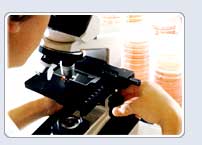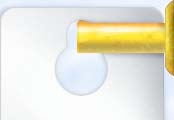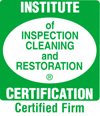- Mold Testing should be done if you
want to determine if mold is growing in you home.
- Mold Testing should be done after any flooding or water damage event.
 Mold Testing should be done whenever
you find a leak that has been present for more than 24 hours.
Mold Testing should be done whenever
you find a leak that has been present for more than 24 hours.
- Mold Testing should be done whenever
you smell a moldy odor.
- Mold Testing should be done if
residents of your home experience a long-term medical condition
without a known cause.
- Mold Testing should be done if
unusual stains appear on furniture or building material.
- Mold Testing should be done if you suspect
mold but do not see any visible mold growth
One of the latest tools Mold Inspectors can use to detect mold
in places that cannot be seen easily is the BCAM® infrared
camera. (Flash Video)
This kind of equipment and technology offers the mold inspector
a non-invasive means of monitoring and diagnosing the conditions
of buildings - providing immediate high-resolution thermal imagery,
revealing potential structural and moisture issues, energy efficiency
and even rodent or pest discovery.
The BCAM® infrared camera features an automatic color alarm alerts
yout to moisture-laden areas during building scans which can
detect potential areas of mold growth, as well as verify when structures
are moisture-free during the drying out process.
With the BCAM the Mold Inspector can inspect places that
can't be physically reached with moisture meters. The BCAM reveals
wet conditions behind surfaces such as: enameled walls and wallpaper
that don't readily water stain, track leaks to their source, monitor
the drying process, and confirm when a structure is dry.
Indoor Air Quality (IAQ) deals with the content of interior
air that could affect health and comfort of building occupants.
The IAQ may be compromised by microbial contaminants (mold, bacteria),
chemicals(such as carbon monoxide,radon}, allergens, or any mass
or energy stressor that can induce health effects.
Often it is
perceived that outdoor air is polluted, but indoor air is acceptable.
Scientific studies illustrate the falsity of this perception,
and, in fact, indoor air is often a greater health hazard than
the corresponding outdoor setting.
Techniques the inspector uses for analyzing IAQ include: testing
of air samples, collection of samples from building surfaces.
The testing samples are analyzed for mold, bacteria, chemicals
or other stressors, depending on the test type. These investigations
can lead to an understanding of the sources of the contaminants
and ultimately to strategies for removal of the unwanted elements
from the air.
So you have a mold problem,
now what do you do about the
mold removal and the mold remediation?
According
to the EPA, if the mold covers an area of less than ten
feet (a patch of about three feet by three feet), then you can probably
clean it yourself.
If the area of mold is larger than
a 10 foot radius, you should
probably consult a professional.
The EPA also
suggests that if your mold is toxic mold, regardless of the size
of the problem, you should again seek the services of a certified
mold removal professional.
A variety of mold remediation methods
that are available to remediate damage to buildings and furnishings
caused by moisture-control problems and mold. The mold remediation
procedures selected depend on the size of the moldy area and
the type of contaminated materials. Budget may also be a concern.
It is impossible to remove all mold and mold spores indoors;
some mold spores will be found floating through the air and in
house dust. The mold spores will not grow if moisture is not
present. Indoor mold growth can and should be prevented or
controlled by controlling moisture indoors.
If there is mold growth in your home, you must clean up the
area, remove the mold and fix the water problem.
If you clean up the
mold, but don’t
fix the water problem, then, most likely, the mold problem will
come back.
Molds can gradually destroy the things they grow on.
You can prevent damage to your home and furnishings, save money,
and avoid potential health problems by controlling moisture and
eliminating mold growth.
Can
Mold Cause Health Problems?
In general, mold spores cause an allergic reaction when they are inhaled from
the environment.
Molds can be broken down into indoor and outdoor molds.
Both will thrive in moist, dark environments and are typically more prevalent
in the summer months secondary to the increased humidity but are present year-round.
The outdoor molds, surprisingly, reach their peak levels in the
evening when the temperature decreases.
Often, people will cut and water the lawn in the evening, which will dramatically
increase the circulating mold spores in the air.
It is advisable to wear a mask when working around any grass, leaves or trees.
Again, the mold spore count tends to increase in the evening hours, so it would
be best to avoid yard work during these times.
Rain will also cause the release of mold spores, which is in contrast to pollen,
which will decrease with rain exposure.
The indoor molds are present year-round, and will be found anywhere moisture
collects.
Common places include under sinks, drains, drip pans beneath refrigerators
and freezers, condensers of air conditioners, old books or newspapers, and
shower curtains.
Mold Free Home Va Services the District of Columbia, the Washington,
DC Metro Area of Maryland and Virginia Regions.
Moldfreehomeva LLC is a Licensed and Insured Company.




 Mold Testing should be done
Mold Testing should be done



